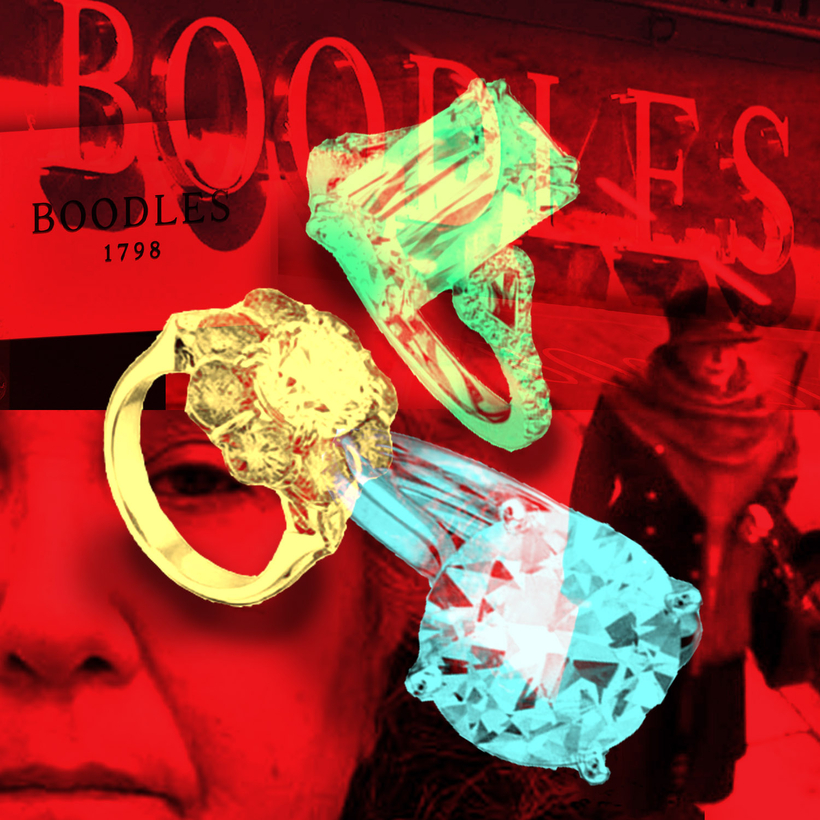To the four C’s of diamonds (carat, cut, clarity, and color), might we now add a fifth? Cheek, perhaps. Or chutzpah. Or maybe simply cojones.
Lulu Lakatos, the alleged jewel thief currently on trial in London for one of the most audacious and delicious heists in recent memory, certainly appears to possess all three in good measure—although her overwhelming physical attributes, it should be said, are decidedly more female than male.
When Nicholas Wainwright—chairman of Boodles, the 223-year-old gem dealer on the receiving end of the theft—remembered that fateful day in March 2016 in court last week, one image seemed seared into his memory above all others. “She had enormous boobs,” he said. “And you could see her cleavage. It was most unattractive.”

Most effective, too. Within just a few short minutes of entering the fiercely guarded jewelry store, Lakatos—dressed distractingly, according to Wainwright, in “the sort of thing a Russian dancer would wear”—had strolled back into the Mayfair sunshine with seven huge diamonds resting in her handbag.
Bamboozled by her unorthodox appearance (and paralyzed, it seems, by a very English horror at making a scene), the proprietor of the family-owned jewelry shop had been fleeced out of $5.8 million in glittering carbon—an Ocean’s 11–grade caper of “the highest possible sophistication, planning, risk, and reward,” according to the prosecution.
“She had enormous boobs,” he said. “And you could see her cleavage. It was most unattractive.”
The ruse begins in Monaco, as all good ruses tend to. And the details are worth poring over. A few weeks before the Mayfair sting, Boodles top dog Wainwright is approached by an Israeli man calling himself “Simon Glas,” who claims he wants to invest some cash in high-grade diamonds.
Wainwright promptly heads down to the Hôtel Métropole Monte-Carlo to meet the investor for lunch (alongside a counterfeit oligarch), and the two parties soon agree on a deal—pending sign-off by the buyer’s very own diamond authenticator.
Enter Lakatos, allegedly posing as “Anna,” a gem expert who pops over to London to meet Wainwright—along with Boodles’s in-house gemologist Emma Barton—in the New Bond Street store. Arriving in a demure camel coat and thick-framed glasses, Anna is escorted down the glass spiral staircase into the private room below the shop—before unrobing to reveal a divertingly low-cut black dress.

Here, she begins to clumsily inspect the gems. “She didn’t know how to use her equipment very well,” Barton remembered in court last week. “She didn’t use a loupe, a jeweler’s eyeglass. As a first point of call, that is what you would generally do,” she continued. “It did make me question the qualifications that ‘Anna’ had.”
Next, Anna wraps each gem in pre-cut pieces of tissue paper, before placing them one by one into small boxes, which are then put into a pouch-like purse, which is finally zipped closed before being padlocked shut. And then—the turn.
At this moment, Wainwright happens to receive an urgent phone call from Russian buyer “Alexander” and has to momentarily leave the room. Just as he ascends the staircase, Anna places the purse in her bag, much to Barton’s panic. “I said, ‘No, no, no, you can’t do that,’” the gemologist later recalled. “‘Please take the diamonds out of your handbag now. I have to be able to see the diamonds at all times.’”
Anna stays perfectly calm. “It’s O.K., don’t worry, there’s nothing to worry about,” she says, before removing the pouch from her handbag just two seconds later. This is the moment where a sleight-of-hand switch is made for a purse identical in every way—except for the fact that it contains not priceless gems but “garden pebbles.”
The family-owned jewelry shop had been fleeced out of $5.8 million in glittering carbon.
After a swift “gentlemanly” search of Anna’s handbag reveals nothing untoward—it is thought that the bag contained a false bottom or fake compartment—Wainwright places the dummy purse in the Boodles safe. He then allows his buxom nemesis to trot out the front door, where she meets two female accomplices who had been browsing in nearby Cartier and Ralph Lauren, and palms the real purse to one of them.
Then it’s a quick pit stop in a pub bathroom for an outfit change, a hop up to St. Pancras station—and a relaxed journey aboard the Eurostar, under the Channel and into France. From patsies to pastis in a few hours.
Smelling a rat, the Boodles high command soon cracks open the purse, revealing seven worthless pebbles inside, and immediately raises the alarm. Lakatos—who is alleged to have played the role of Anna—is finally apprehended in France on a European arrest warrant last September, and extradited to the U.K. shortly afterward. An open-and-shut case—except for a late twist that may yet blow the trial wide open.

In a quite remarkable defense, Lakatos has now claimed that the femme fatale at the heart of the gambit was in fact her younger sister Liliana Lakatos. Lulu alleges that Liliana had borrowed her passport, dyed her hair gray to resemble her then 55-year-old sister, and traveled from France to England to carry out the heist.
Conveniently for the defense, Liliana died in a car crash in the family’s native Romania in 2019—but not before allegedly confessing to the crime to Lulu in full.
“If my sister was alive she would be standing here,” Lulu said in court last week. “She would have preferred to have been in jail because you can come back. But you can not come back from where she is now.”
The defense is not as far-fetched as it might first appear. In fact, Liliana had been convicted multiple times for theft in France, and charged with possession of criminal property in England, too. Her most recent address in the U.K., it has now emerged, was the exact hotel in northwest London that was later used as a base by the gang involved in the Boodles heist.
But most intriguing of all is the uncanny resemblance to a similar sting apparently concocted by Liliana in Switzerland in 2014, where a woman matching her appearance swiped $530,000 in notes from AEK Bank before swapping them for a stack of worthless paper. There was an unguarded safe, a perfectly timed telephone call, and a flustered manager on that occasion, too.
Ioana Nedelcu, speaking for the defense, said Liliana was “an international thief of international calibre,” who, in the Swiss-bank heist, had deployed “exactly the same modus operandi as in this case.” And, in May, Barton had picked Liliana out in a police lineup. What’s more, a DNA sample recovered from the pebbles found a “very strong” link with Lulu and a possible link with her sister, the court was told.
The prosecution scoffed at the story—painting the defensive ruse as a stranger-than-fiction thriller plot that stretched the court’s credulity to its limit. But it befuddled the jury sufficiently to prompt over nine hours of debate and wrangling—before Lulu was found guilty of conspiracy to steal by a majority of 10 to 1.
Judge Emma Goodall, Q.C., summarized the ploy neatly in her closing statement. “You spent almost an hour in the Boodles London showroom exploiting their trust,” she said, “which allowed you to engage in a brazen deception and through sleight of hand you stole seven diamonds valued at $5.8 million.” The prosecutor likened it all to a scene from a Hollywood film, and Lakatos wept theatrically in the dock as she received a prison sentence of five-and-a-half years. Ample time, perhaps, to reflect on her crimes, write her memoirs—and ready herself for the Netflix adaptation.
Joseph Bullmore is a Writer at Large for AIR MAIL


